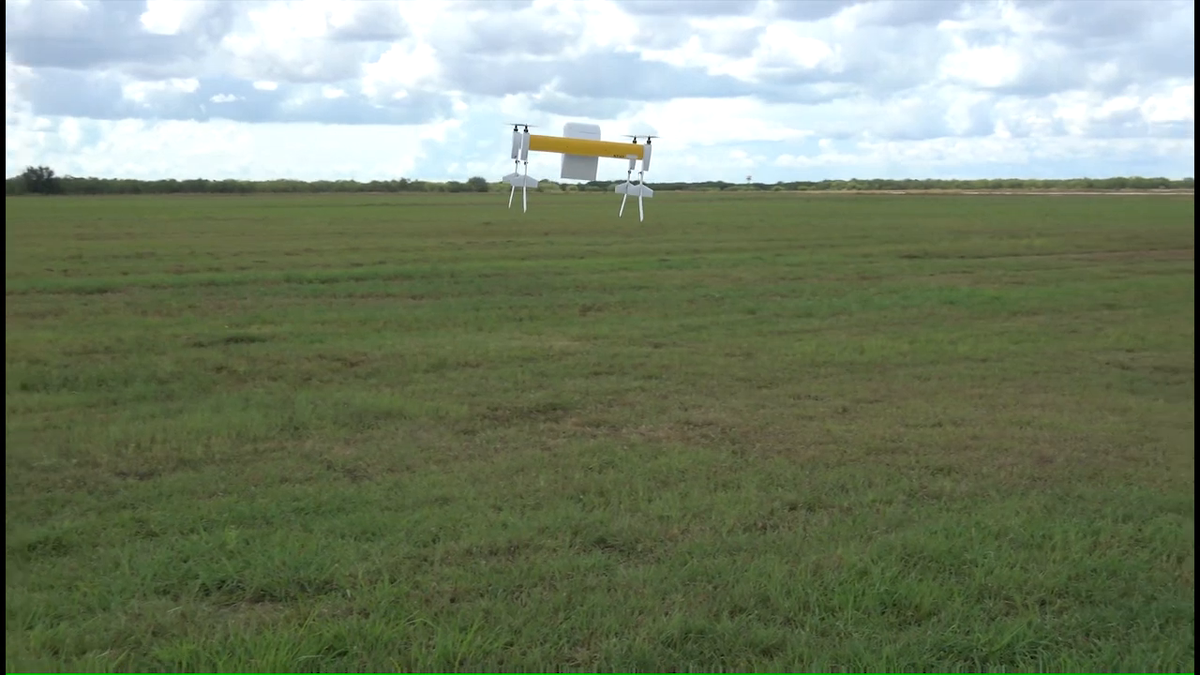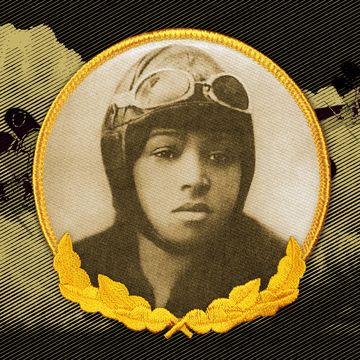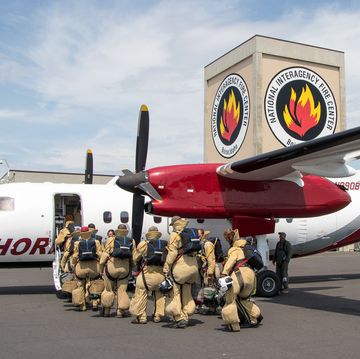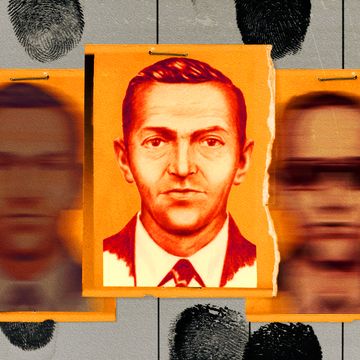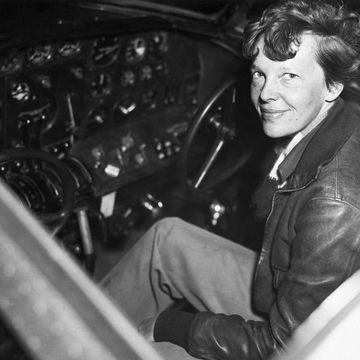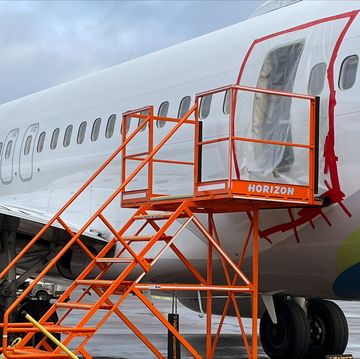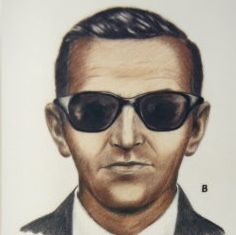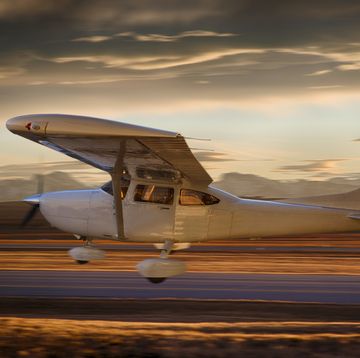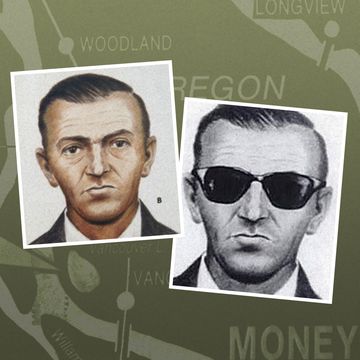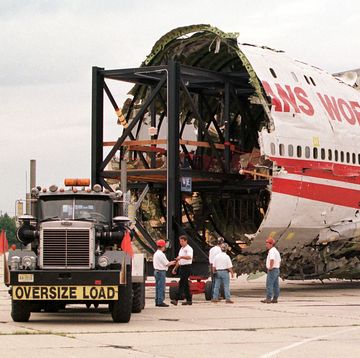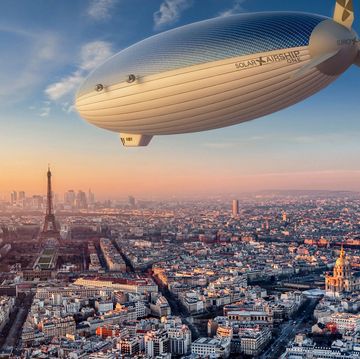We have squared up to the double unbroken yellow lines that separate the taxiway from runway 28 at Caldwell Airport in Fairfield, New Jersey. It is my second flight lesson inside Six-Two Romeo. My instructor is Tom Fischer: shaved head, tinted specs, a fresh company polo every day. Between lessons, Tom puts out fires set by regulators, mechanics, staff instructors, student pilots, calls of nature, and the demands of lunch. And that's just what I know about. Circling his head, who knows: forecasts, fuel costs, dreams of franchises. On the ground he can seem beleaguered. He can seem harried and curt. But put him inside a plane and the man transforms into an angel of patience and calm.
We have run through the pretakeoff checklist, which includes making sure the flight controls are free of any last-minute obstructions and that the engine doesn't peter out suddenly when throttling down. It's prudent, when taking off, to have working controls and a running engine. Before radioing to the tower to request clearance, Tom informs me that today I will be doing everything on my own to get us up into the air.
My first lesson was easy. I was so unsure of everything, so frightened and awed, that going up wasn't half as bad as all that dreadful anticipation. I'd even say it was fun. But then, Tom did almost everything: takeoff, landing, a lot of the pilotage. I turned the yoke to the left, I turned it to the right. Wheee! I learned where the throttle was located. "Is this the throttle?" I kept asking Tom, pointing. "Which way does it go again?"
When Tom tells me that I alone am in charge of getting us up into the air, I have to ask myself: Which one is the throttle again? Which way does it turn?
A word about your pilot: When it comes to the physical world, I've always considered myself at something of a loss. I'm talking about switches and levers, valves, winches, latches and locks, hasps, handles, knobs, and hinges. If it needs to be pushed, I pull it. If it turns clockwise, I try to yank it out. I poke instead of flip and jimmy when I should toggle.
The instrument panel on Six-Two Romeo, less involved than those you spy on your way back to coach, nevertheless bristles with knobs and switches. Now, it's one thing for me to confuse the volume knob for the input knob on a stereo receiver; it's another thing to get confused inside Six-Two Romeo, where every mistake is potentially fatal. Not really, or not likely, because Tom is in the plane with me. But my irrational fear isn't contained by the knowledge that Tom is in the plane. Irrational fear whistles like the wind at the windows. It kicks the stomach into gear like so much turbulence. It drowns out every word of Tom's helpful instruction.
Tom reviews how the throttle works. Then he reminds me to engage the right rudder pedal as we go down the runway. The right rudder offsets the airplane's natural tendency to yaw to the left, a consequence of the propeller's asymmetrical thrust. But overcome as I am by the anxiety of getting us up into the air alone, as we take off I forget which one I should be using. The left? The right? I decide that it must be the left. I punch the throttle in and off we go—not trending but hurtling to the left like a clown car under a big top.
Tom wrestles the plane under control. As it happens, we are forced to abort takeoff anyway when a groundhog pops out of its hole and scurries across the runway.
I became obsessed during my time in the plane with the question of initiative. How did I reach out and willfully take control of an airplane I didn't yet know how to fly? I didn't want to make a mistake. Up there, mistakes seemed like a -matter of life and death. Let Tom reach for the controls, I thought. He's the expert. But then how would I ever learn?
I'd been flying for about a month when, after a lesson of one deplorable landing after another, Tom prescribed two hours in the simulator. I was making too many involuntary mistakes very near the ground: coming in too fast, rolling the plane at the last minute, yanking up on the yoke and causing the runway to disappear beneath us. "You can't land on a runway you can't see," Tom sensibly suggested. He wanted me out of the plane and in a controlled environment where we could pause the action at the moment I made a mistake and zero in on its causes.
The dubious advantage to simulated flight is emptying the cockpit of everyone but yourself, so that you see just how spectacularly you would crash without your flight instructor beside you. It's oddly as nerve-racking as the real thing. I consistently came in far short of the runway. One landing in particular, I found myself wildly, dramatically short—so short I was on course to crash long before the runway began.
"Tom," I said. "I seem to be short of the runway."
I acknowledged the problem all right, but I did nothing to correct it. I did not raise the nose. I did not increase the power. I might have throttled all the way up and reentered the air, but that possibility didn't even occur to me. I just keep sinking until I hit the earth, which I did very, very hard. I looked back at Tom, who was sitting behind me at the computer.
"What interests me," he remarked dryly, "is why you would say that and not do anything about it."
That was the mystery! I just couldn't spur my will into action. What is the will? I tend to think of it as a secret power, something that erupts from me but remains independent of me. I do not will my will—it just is. It just does. But it can't do what it does not know how to do. It holds back, remains absent, is in some way in negotiation with my intelligence. They have a back-and-forth. Will: Master all the instruments and the control panel and I will fall in line. Intelligence: But how am I going to master anything when you refuse to engage? Will: I'm saving our life by not engaging, pal. Intelligence: But you're also preventing me from learning. Will: I'm preventing you from making stupid mistakes, you idiot! Intelligence: If you won't engage and I can't learn, how will we ever do a solo flight? Will: A solo flight? As in, a flight without Tom? Intelligence: That's the goal here! Will: Good luck getting me into the plane on that day.
Worried as I was that a mistake might be fatal, positive action in Six-Two Romeo would have implied that I was, in some way, okay with dying, that I had accepted the possibility. I wanted to fly, sure, but I didn't want to die.
Tom Fischer says that the closest anyone comes to dying during a flight lesson is on the drive to the airport. In my case, it's true: I zoom through the city and over the bridge on roads with lunar potholes and dips made for motocross. I sandwich myself between two semis on I-80 as I drift upwards of ninety miles per hour. The steering wheel is a thing of familiarity and common sense, and I can brake on a dime without thinking.
If my sense of safety and control in a rental car is an illusion, it's a useful one, allowing forward motion. The conditions are reversed inside Six-Two Romeo. I'm surrounded by peril, I feel, and though the yoke is in hand and the throttle within reach, the illusion is one of paraly-sis. Lacking perfect know-how, I lack agency. I can't take the initiative.
Part of my inaction is due to irrational fear, and part of it is due to the many technical things I have yet to learn. I have to learn how to use the controls: the yoke, the ailerons, the rudder pedals, the throttle, the trim tab, the flaps. I have to learn how to pilot: how to climb, how to descend, how to hold a steady course. I have to learn how to use the instrument panel and how the readings work in tandem with the controls. I quickly learn that, in a medium as marvelous as air, there is no such thing as an independent change. A simple bank to the left might require a change in pitch. It might require a change in rudder. It might initiate a change in airspeed. It will almost certainly change my heading. Once I commit to memory all of these interrelated changes and learn how to anticipate, accommodate, and modify them according to my piloting goal, I have to fold in the complications of wind and weather. Once I get a handle on weather, I have to learn how to navigate over unfamiliar terrain. Once I learn how to navigate, I have to learn how to communicate with air traffic control. More daunting than any of this, I have to learn how to land.
My second lesson was more or less an introduction to all this. For my third lesson, I'm no more prepared for what Tom suggests than I was for getting us up into the air on my own.
"What maneuvers have you been reading about that you'd like to try out?" he asks on our walk out to the apron where Six-Two Romeo is parked.
I wouldn't mind the maneuver with the hot towels. Or the maneuver with the warm mixed nuts. Or the maneuver where I roll over and sleep until we're an hour outside of Shanghai.
"How about stalls?" he asks. "Should we do some stalls?"
Now, I have read about stalls, online and in books. I'm aware that they exist. The word "stall" captures the attention like little else. It evokes breakdown, arrested midair motion, an immediate and irrecoverable fall from the sky. Stall the plane by some terrible piece of luck, according to my magical thinking, and you do not live.
"You can stall the airplane?"
"Of course you can."
"And then what?"
"Then you recover," he says.
"You can recover from a stall?"
"I certainly hope so."
"And you stall the plane while inside it?"
Tom appraises me with silence and something on the borderline between confusion and derision.
"Where else would you be?" he asks.
I suspect that Tom has a hard time understanding the fear I take up into the air with me. He comes from a family of pilots and has been flying from a young age. He commands Six-Two Romeo the way John Wayne once rode a horse. And he goes up many times a day with student pilots of wildly varying proficiency, overriding all their mistakes. He has lost touch with what's scary about flying, if indeed he ever knew that fear to begin with. If he can tap into my fear, it's a purely intellectual exercise. Which is as it should be: If he shared it, we would be two quivering ninnies hurtling to our deaths in no time at all. His confidence that we have nothing to be scared of is the only reason I ever stepped foot in Six-Two Romeo. He takes my fear as a matter of faith and I take his confidence as a matter of faith, and between us, we have almost nothing in common.
We also have little in the way of a shared language. Three-dimensional flight is conceptually challenging; grasping those concepts, envisioning them, gaining a feel for them through words alone, is next to impossible. "Guard the yoke . . . stretch out the power . . . pitch for airspeed, not the runway . . . turn longer, not steeper . . . okay, now hold it off, hold it off, you can't force a plane to land . . ." I don't understand a thing.
We do clearing turns over the onion fields. Then Tom says to me, "Okay, let's take some power out."
This is all so new to me, and I have been so chronically afraid of flying for so long that I'm possessed by magical thinking inside Six-Two Romeo. If I shift in my seat, I believe I will throw the plane off balance. If I press down too hard on the rudder pedals, my feet will plunge through the floor panel. If I let go of the yoke, the plane will nose down like a dart and explode in the onion fields. I can't overcome my amateur conviction that every control input or change in attitude has no margin of error and is quickly irreversible, unmanageable, and doomed.
What Tom doesn't know is that I have deliberately refrained from shifting in my seat to magically prevent bad things—like the power going out—from happening. I have coaxed from the airplane, by the assiduous application of my ass, its promise that it will not lose power. Why would we willfully undo all of my hard work?
"Go ahead," he says.
I reach for the throttle and pull it back. The engine's roar falls to a purr, and we are suddenly floating in comparative silence. Seconds pass. I have nearly lifted my entire body off the seat in order to keep us aloft. If there were ever a moment when the plane should fall from the sky, this would be it.
But we don't fall.
We shed speed: eighty knots, seventy, sixty. We keep the nose pointed up in order to maintain our altitude, which kills our speed even further. I expect a plummet, a midair breakup.
We get only slower flight.
"Okay, now put the power back in."
I return the throttle to full power and the engine resumes its roar. I have been laboring under the illusion that something so dramatic as a reduction in power to the engine is irreversible—but I take the power out and I put the power back in, and the engine just goes along with the show.
"Now we pitch up, as we do when lifting off the runway."
I do nothing.
"Go ahead," he says. "Pull back on the yoke."
"Pull back on it? Are you sure?"
"I'm sure," he says.
"How far?"
"Fifteen degrees."
Fifteen degrees makes for a dramatic climb. We seem to be pointed at the sky like a rocket. We are taking off again from runway 28 at Caldwell—only this time at 2,500 feet in the air. This is the purpose of the power-on stall maneuver: By mimicking what might go wrong on takeoff, we familiarize ourselves with those conditions so that, should they arise at that critical time, we stand a chance of correcting them. But during practice we do so with the luxury of altitude. The windscreen fills with the white of God, and my eyesight, which guides me through most things in life, becomes secondary. A climb like this is almost entirely about the body. We seem to be inside some kind of compression chamber or intergalactic pod where there is simultaneously sensory deprivation and the introduction of an overwhelming stimulus, a vibration evolving toward a shudder, as in a washing machine with an unbalanced load. It is the opposite of that gentle float we were in just seconds ago, when things were benign and fluffy. It is everything, in other words, that I've been taught to expect from movies and nightmares of an airplane about to crash.
But we don't crash.
"Okay, now pop it," says Tom.
He wants me to pull back on the yoke all the way, to kill what remains of our lift. I do and we stall. Until now, I would have believed recovery impossible from such dramatic behavior—arresting an airplane in midair!—and that we would plummet to our deaths. And we do plummet, a little, as I push the yoke forward at Tom's instruction. We glimpse the green earth of New Jersey in the windscreen. By descending we regain speed. I pull back on the yoke, arrest our fall, and level off. We enter a positive climb and reclaim our lost altitude.
I experience all of this with the most wide-eyed wonder. More wondrous still is my active participation. I'm struck dumb by my contribution to this seemingly reckless, perfectly natural in-air performance. The plane has acted in keeping with the laws of physics and the laws of mechanics and the laws of flight schools everywhere. An airplane is not, it seems, a magical thing with occult intent. It is a dumb and analog machine that does what the wind and I ask of it.
Fear continued to get me throughout my flight training. I made big mistakes because of it. I had a bad habit of choking the stick, as if the tighter I held it, the safer I would be. But it was the opposite that holds true. The stick, or yoke, is a subtle and sensitive instrument; by throttling it in a death grip, I foreclosed all delicate input changes, continually threw off my airspeed, prompted many unwanted rolls, and turned into a loose cannon whenever we tried to land—everything I hoped to avoid by choking the stick! "Stop pinching the yoke," Tom told me I don't know how many times. "How would you like to be pinched?" Sometimes I think that the story of how I learned to fly resolves entirely into the story of how I learned to take hold of the yoke less like a chicken's neck and more like a sweetheart's hand. I couldn't do that until I rid myself of fear.
Between my ninth and tenth flying lessons, the fever broke. I don't know how or why. Part of it was simply accumulating time in the air. After ten or so hours, I no longer had any reason to think the plane crashed by magic. And part of it was a better technical grasp of the many aspects of flying. I gained confidence in my power to make the airplane predictable. That is the pilot's preeminent goal.
But another part of it was a growing fatigue, even a disgust: I was sick of being scared. I was tired of not taking the initiative.
I wanted to fly. I wanted to have fun.
Before my first lesson, I asked Tom if I was going to die. Tom is a circumspect man, careful to choose his words, but never at the expense of a forthright answer.
"Eventually, yes," he said. "Nobody gets out alive."
Later, he added, "Now, are you going to live? That's another story. That's a subjective question. Not dying is not the same as living."
One day, Tom and I went up with barely a word exchanged between us. We climbed out of Caldwell and over the golf course, its tiny sand traps amoeba-like at that distance. I turned over I-80, still climbing, and turned again to the downwind. I arrested the climb at pattern altitude and called back the power from the red line. At midfield I radioed the tower for permission to do a touch-and-go on runway 28. I reduced power and began a positive descent before I turned base to final. The runway came into view and I reminded myself to go easy on the yoke. We passed over the little fence that divides the highway from the airport. I kept a steady sight picture of the numbers on the runway so as not to come up short as I had on the simulator. I came in not too fast, not too slow, not too high, not too low. I rode the flare, holding off on touching down, and at the moment of truth, slowly set the wheels on the ground. Once the nosegear kissed the runway I immediately powered up again, climbing out once more over the golf course into a fine bright winter's day.
At the outset of my flight instruction, I did not think it possible to take the plane in hand from start to finish. Where had the will to do so come from? I didn't know. Somehow, the will can be nurtured. Somehow it can be flexed, like a muscle, and strengthened. What a mystery! A mystery on the order of the soul.
A half a dozen touch-and-goes later, we ended the lesson, and I taxied Six-Two Romeo back to the apron. "I don't know if you know this or not," said Tom just before we stepped out of the plane, "but I didn't touch the controls a single time today." I had done everything, from first takeoff to final landing, without a single input or correction from my flight instructor.
Yes, the risk of flying in an airplane is dying in an airplane. But if I kept flying under the influence of fear, I would never have learned to fly. I would have kept Tom next to me at all times, deferring to him, living through him. God knows I wanted to avoid dying at all costs, but not if it meant not living. Nothing I learned when learning to fly was quite as important as that.
This story appears in the June 2015 issue of Popular Mechanics. It is part 2 of 4 of Joshua Ferris' "Learning to Fly" series. Read part 1 here.


